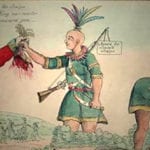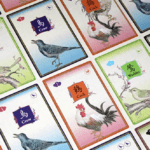Today, we wrongly apply the Suffragette label to everyone in the suffrage movement, both peaceful and violent, but the Suffragettes were not peaceful women, politely waiting for men to give their rights. They were violent. They were vicious. They were domestic terrorists who lived up to their motto: “deeds, not words.”
10Trying To Assassinate The Prime Minister
On July 19, 1912, a group of Suffragettes nearly killed the Prime Minister. Prime Minister Herbert Asquith, a key opponent of the Suffragettes, was visiting Dublin. He was traveling by carriage with the Irish politician John Redmond when suddenly a hatchet flew toward him. It landed directly between the two, grazing Redmond’s ear, only a few inches away from killing him. On it were written the words: “This symbol of the extinction of the Liberal Party for evermore.” The woman who threw it was Mary Leigh, and she was only getting started. She managed to escape in the commotion and, with a few friends, made it to the Theatre Royal, where the prime minister was scheduled to speak. Leigh and her friends poured a combustible oil on the theater’s projector and set it on fire. Some men saw it burning and rushed in to put it out, but as they did, an explosive went off in the audience. When they turned to the sound, they saw Leigh’s co-conspirator, Glady Evans, blocking the door out of the protecting room. She had a lit match in her hand—and she threw it onto the oil around those who trying to calm the flames. The girls were arrested, and the fire was stopped. As she was dragged off, though, Glady Evans swore that there would be more explosions to come. “This,” she promised, “is only the start of it.”
9Bombing A Chancellor’s Cottage
The Suffragettes had an active campaign of actively destroying property. They set letter boxes on fire, smashed shop windows, cut telephone wires, and burned buildings to the ground. They targeted buildings dominated by men. Golf courses that forbade women, in particular, would be dug up, with slogans graffitied across the greens and buildings set aflame. They nearly killed 12 men when they bombed a cottage that belonged to politician Lloyd George. George was an outspoken advocate of women’s rights—but the Suffragettes didn’t feel like he was doing enough. “He is always betraying us!” one Suffragette complained. She justified bombing his cottage, saying she believed it would “wake him up.” Two bombs were concealed in his cupboards, set to explode at a time when they thought the house would be empty. The Suffragettes, though, didn’t realize workers were coming in that day. By a miracle, the second bomb didn’t go off, but if it had, the men would have been killed. The arsonists were never caught, but Emmeline Pankhurst took the credit for organizing the attack. “For all that has been done in the past I accept responsibility,” she told the courts, before being sentenced to prison. “I have advised, I have incited, I have conspired.”
8Vandalizing Famous Pieces Of Art
After Pankhurst was arrested, a woman named Mary Richardson went into the National Art Gallery, walked up Diego Velazquez’s Rokeby Venus, and slashed it to pieces with a meat cleaver. “I have tried to destroy the picture of the most beautiful woman in mythological history as a protest against the government for destroying Mrs. Pankhurst,” she declared, “who is the most beautiful character in modern history.” Richardson’s attack inspired other Suffragettes. Another woman, Mary Wood took a meat cleaver of her own to a painting of Henry James, crying out, “Votes for women!” while she hacked at it. Another woman put a blade in a portrait of the Duke of Wellington, and another cut up Lausen’s Primavera. Their biggest hit, though, was the coronation chair at Westminster Abbey, where kings were crowned. A woman smuggled a bomb loaded with iron nuts in a small black bag and placed it nearby, hidden under a feather boa. It went off, blowing off a piece of the chair. “I wish to show the public that they have no security for their property nor for their art treasures,” one of the vandals explained when asked why she’d done it, “until women are given the political freedom!”
7Hunger Strikes
When Emmeline Pankhurst was sent to prison, she immediately staged a hunger strike. This was a common Suffragette strategy. Marion Wallace Dunlop had staged one of the first in 1909, and it had worked. After three days of starving herself, the warden, unwilling to let her die, had released her. When other women followed suit, though, jailors started force-feeding them. A hunger striking woman would be tied down to a chair. Her mouth would be pried open with a steel gap, and a rubber tube would be jammed down her throat, usually tearing up the throat tissue. Some women went through this process more than 200 times. Nobody got it worse, though, than Frances Parker. Her captors force-fed her rectally, and, it seems, did much more than that. When the prison doctor examined her, he found injuries that he described as “consistent with an instrument having been introduced into the vagina.” Parker ultimately broke out of jail, desperate to get away from the abuse. The government wasn’t about to risk force-feeding someone as influential as Emmeline Pankhurst. When her strike started, they rushed a new law known as the “Cat And Mouse Act.” Under this law, they could let Pankhurst go—and arrest her again as soon as she was healthy.
6The Jujitsu-Trained Bodyguards
Pankhurst had no intention of going back to jail. And so she called on the help of Edith Garrud, official Jujitsu instructor of the Suffragettes. Garrud was a tiny woman, less than 5 feet tall, but she could fight. She’d already starred in an early martial arts film and ran her own dojo. Now, she taught Jujitsu to Suffragettes, believing they could use their attackers’ strength against them and knock them to the ground. Garrud would go to events dressed in a red gown, and she would invite trained martial artists to attack her. She set up a dojo at the Golden Square to train any women who were interested. It was so popular that girls around the country started setting up “jujitsu parties” of their own, where they trained one another. Once Pankhurst was released, Garrud trained an elite team of female, armored bodyguards to guard Emmeline Pankhurst. They followed her around with clubs hidden up their dresses. Whenever the police tried to take Pankhurst away, they would pull out their clubs and strike.
5Emmeline Pankhurst’s Decoys
With a warrant out for her arrest, Emmeline Pankhurst decided to deliver a speech in Camden Square. A crowd of people—some Suffragettes, some protesters who opposed every part of her movement—came out to watch. And among them were a throng of police officers, waiting to arrest her. Pankhurst, a veil over her face, walked out on the balcony. Before the crowd, she lifted it up, revealing that it was really her. “I had reached London tonight in spite of armies of police. I am here tonight, and not a man is going to protect me, because this a woman’s fight, and we are going to protect ourselves!” she told the crowd. “I am coming out among you in a few minutes and I challenge the government to re-arrest me!” Pankhurst came out a moment later, surrounded by her jujitsu-trained, club-wielding bodyguards, the veil over her face. The police rushed her, and pandemonium broke out. The mob turned violent, protesters clashed with officers. Pankhurst was knocked unconscious, dragged into a police car, and driven away. But when the police took off her veil, it wasn’t Pankhurst they saw. The woman they’d nabbed was someone they’d never seen before. Pankhurst, in the commotion, had snuck out the back and driven away.
4Stabbing People With Hatpins
Jujitsu wasn’t the only form of self-defense the Suffragettes could use. They also had their hatpins—and they knew how to kill a man with them. The hatpin went from accessory to weapon in 1903, when a Kansas girl named Leoti Blaker was accosted by a man in New York. He’d started creeping closer and closer to her and, when he put his arm around her lower back, she pulled a foot-long hatpin out of her hair and stabbed it in his arm. “He was such a nice-looking old gentleman. I was sorry to hurt him,” Blaker said afterward. But she explained, “if New York women will tolerate mashing, Kansas girls will not.” The Suffragettes rallied behind her, and she inspired a whole wave of hatpin attacks. Women around America, following Blaker’s lead, started slashing man who tried to sexually harass them with their hatpins or beating them with umbrellas. Soon, hatpin attacks were so common that, in 1910, Chicago passed a law making it illegal to carry a hatpin longer than 9 inches. To the Suffragettes, this was a perfect example of why women needed the right to vote. “No man has a right to tell me how I shall dress,” a woman named Nan Davis declared. “If the men of Chicago want to take the hatpins away from us, let them make the streets safe.”
3Using Tax Laws To Send Their Husbands To Jail
One woman, named Dr. Elizabeth Wilks, had her husband sent to jail to make a statement. At the time, men were legally responsible for their wives’ taxes. It was a sexist law meant to discriminate against women, and, usually, it did. Men were entitled to their wives’ tax refunds, while wives were entitled to nothing—and Wilks wanted to highlight just how unfair this was. Wilks made more money than her husband did—she was a doctor, and her husband was a teacher. So, to prove a point, she stopped paying her taxes. Her husband protested, but she openly and publicly refused to pay them, and he couldn’t afford to pay them himself. Since her husband was legally responsible, he got sent to jail for her tax evasion. The men of the world were furious. She had sent her own husband to jail, they protested, simply to make a point. To the Suffragettes, though, their anger was proof their point had been made. Men, one said, were unable “to realize the extent of any injustice until it touches himself.” Most of these laws were unfair to women, but Dr. Wilks had found one that was unfair to the men—and now the men were protesting.
2Emily Davison Threw Herself In Front Of A Horse
Emily Davison was one of the more militant suffragists. She had set fire to mailboxes, smashed windows, and once famously hid in the cupboard of the House of Commons so that she could claim it as her residence on the census. All of her actions got her sent to prison, where, like many Suffragists, she went on hunger strikes and went through force-feedings. For Davison, the experience was terrible, and she ended up making a failed suicide attempt in prison by throwing herself down a staircase. After she got out, she went to the Epsom Derby, where King George V’s horse was racing. Davison, as a strange form of protest, jumped onto the track and grabbed onto the king’s horse, tried to pull it over, and got trampled to death. It took Davison four agonizing days to die of her injuries. She went down in history as a martyr for the cause—and horribly traumatized the jockey riding the horse. He attended her funeral, overwhelmed by guilt, and ultimately committed suicide. For years, he told people he’d been “haunted by that poor woman’s face.”
1The Battle Of Glasgow
The police finally caught Emmeline Pankhurst when she gave a speech at St. Andrew’s Hall in Glasgow. The Suffragettes, though, made sure it was as hard on them as physically possible. Pankhurst publicly advertised that she would be speaking at St. Andrew’s Hall, despite the warrant out for her arrest. To get in undetected, her bodyguards smuggled her in a laundry basket and hid her among the audience. 50 plainclothes police officers, though, were sneaking in too, crawling in through the lavatories and hiding in the crowd. Pankhurst stepped out of the audience and onto a stage lined with a bouquet of flowers—and, as soon as she did, the police charged her. The Suffragettes, though, were ready. Hidden behind the flowers was a fence of barbwire. With the police caught in the barbwire, the bodyguards rushed out and fought with the police officers. One woman pulled a gun and opened fire on the officers. It only had blanks, but it sent them into a panic. The police, though, managed to overpower the bodyguards and dragged Pankhurst away. According to one witness’s account, Pankhurst was dragged down the stairs headfirst. When a woman cried out, “For God’s sake, don’t use her so!” a cop knocked her down with his baton, kicked her down the stairs, and trampled over her. The frustrated police exacted every level of brutality—and, in the end, just won more support for the Suffragettes. A few months later, they stopped their militant tactics, and, four years after that, women got the vote. Read More: Wordpress
























